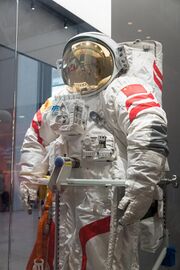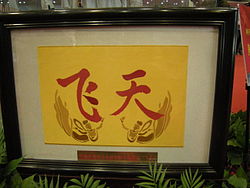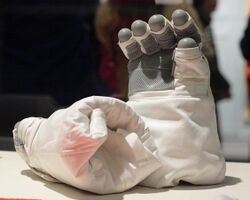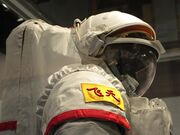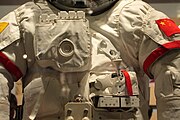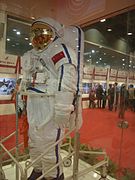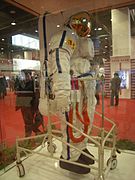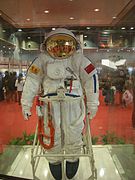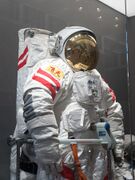Engineering:Feitian space suit
The Feitian space suit (Chinese: 飞天航天服; pinyin: Fēitiān Hángtiān Fù) is an extravehicular space suit design developed and used by the China Manned Space Program. It provides life support, environmental protection, and communications for taikonauts during extravehicular activity (EVA).[1]
The earliest Feitian space suit was used on Shenzhou 7, worn by taikonaut Zhai Zhigang during China 's first-ever spacewalk on 27 September 2008.[2] An improved version of the Feitian space suit is used aboard the Tiangong space station, with the first EVA using the updated version being on Shenzhou 12's first EVA, on 4 July 2021.[3]
As of July 2023, 13 Chinese taikonauts have completed 13 EVAs wearing Feitian space suits.
Name
The name fēi tiān literally and separately means "flying" and "sky" in Mandarin.[4] It is a reference to the flying gods and goddesses feitian, sometimes translated as flying apsara, in Chinese, and most famously depicted in Chinese art in the grottoes of Dunhuang.[5][6]
Images of the feitian from Dunhuang appear on the arm badge of the space suit.[7]
History
When the China Manned Space Program was approved in 1992, one of its "second phase" goals was to develop extravehicular activity capability. To achieve this goal, in the early 2000s, China signed an agreement with Russia to allow import of the Orlan-M space suit to China.[8]
Also in the early 2000s, the Chinese space program began development of its own domestic EVA suit design.[9] The first such suit was assembled in June 2006, and certified in two years later in June 2008.[10]
On 24 September 2008, the China Manned Space Agency announced that China's first extravehicular activity would be conducted by two taikonauts, wearing the Chinese-made Feitian space suit and the Russian-made Orlan-M space suit respectively.[11]
On 27 September 2008, Shenzhou 7 Commander Zhai Zhigang completed China's first extravehicular activity, wearing a first-generation Feitian space suit. The EVA lasted for about 20 minutes. During the EVA, taikonaut Liu Boming remained inside the spacecraft's orbital module, wearing an imported Russian Orlan-M space suit.[12]
Nearly thirteen years after Shenzhou 7, on 4 July 2021, taikonauts Liu Boming and Tang Hongbo of Shenzhou 12 conducted China's second EVA from the newly-launched Tianhe core module of the Tiangong space station, wearing an updated second-generation version of the Feitian space suit.[13] The updated suit design includes two variants, one with red stripes and one with blue stripes, used to distinguish between taikonauts on EVA.[14]
Specifications
First generation
- Mass: 120 kg (260 lb)
- Maximum duration in space: 4 hours
- Minimum number of usage: 5
- Cost: $4.4 million
Second generation
- Mass: 120 kg (260 lb)
- Maximum duration in space: 8 hours
- Minimum number of usage: 15
Gallery
First generation
Second generation
See also
- Shenzhou 7
- Tiangong space station
- List of Tiangong space station spacewalks
References
- ↑ ""飞天"舱外航天服的研制与试验". 2008-09-24. http://www.cmse.gov.cn/fxrw/szqhrw/rwkd/200809/t20080924_38077.html. Retrieved 2023-07-20.
- ↑ Chen, Lou (September 27, 2008). "Taikonaut Zhai's small step historical leap for China". Xinhua. http://news.xinhuanet.com/english/2008-09/27/content_10122420.htm.
- ↑ "Chinese astronauts complete first space walk outside new space station" (in en). 2021-07-04. https://www.nbcnews.com/news/china/chinese-astronauts-complete-first-space-walk-outside-new-tiangong-space-n1273060.
- ↑ Johnson, Ed (September 29, 2008). "China, Following Astronauts' Return, Plans Space Lab for 2011". Bloomberg. https://www.bloomberg.com/apps/news?pid=20601080&sid=aZJYoiU9yivw.
- ↑ "三匹"骏马",星夜伴"飞天"起航 (Three steeds embark on starry night with Feitian)" (in zh). Xinhua. September 28, 2008. http://news.xinhuanet.com/mrdx/2008-09/26/content_10114713.htm.: "“我们想过很多名字,但最终决定把国产航天服命名为‘飞天’。”周建平说,“我们希望,将来我们能够像敦煌壁画上的飞天一样,在太空自由地飞翔。”" ["'We considered many names, but eventually decided to name the domestically made space suit "Feitian",' said Zhou Jinping, 'We hope that, in the future we can be just like the feitian of the Dunhuang murals, and fly freely in space.'"]
- ↑ 敦煌飞天 (The feitian of Dunhuang) (in Chinese). Zhaoqt.net: "飞天,是佛教中乾闼婆和紧那罗的化身。" ["The feitian is derived from the apsara and the gandharva of Buddhist mythology."]
- ↑ "舱外服名字为胡锦涛题写 绣有飞天美女 (Space suit name badge written by Hu Jintao; Embroidered with Feitian female figures)" (in zh). Xinhua. September 28, 2008. http://www.hinews.cn/news/system/2008/09/28/010333006.shtml.: "飞天两个字是绣着的,非常有立体感,是胡锦涛总书记题写的。下面还绣着两个敦煌的飞天美女。" ["The two characters Fei Tian are embroidered, and have a three dimensional feel, and were written by General Secretary Hu Jintao. Below are embroidered two feitian female figures from Dunhuang."]
- ↑ "王兆耀:神七出舱活动俄专家提供了技术支持". 2008-09-24. http://news.sohu.com/20080924/n259726924.shtml. Retrieved 2021-07-04.
- ↑ "中国第一套舱外航天服诞生记(图)" (in zh). 26 September 2008. https://www.chinanews.com.cn/gn/news/2008/09-26/1395955.shtml.
- ↑ ""飞天"航天服技术解密 设计灵感来自一只大虾". http://news.sohu.com/20080927/n259775723.shtml. Retrieved 2021-07-04.
- ↑ "神舟七号载人航天飞行任务第一场新闻发布会" (in zh). 24 September 2008. http://www.cmse.gov.cn/fxrw/szqhrw/ssxx/200809/t20080924_37714.html.
- ↑ Moskowitz, Clara (27 September 2008). "Chinese Astronauts Complete First Spacewalk". https://www.space.com/5902-chinese-astronauts-complete-spacewalk.html.
- ↑ Jones, Andrew (4 July 2022). "Astronauts complete first Chinese space station spacewalk". https://spacenews.com/astronauts-complete-first-chinese-space-station-spacewalk/.
- ↑ "出舱圆满完成!航天员汤洪波再度漫步太空 唐胜杰成我国年龄最小出舱航天员". http://mp.weixin.qq.com/s?__biz=MzA5NTgxNTQzMA==&mid=2650608516&idx=1&sn=a3c1dea0d6008dc04d542e6a51b41aa3&chksm=88b021edbfc7a8fb6aeb70fe7aefcf42d0383e1ac58c094876ee9b7bc1a15f4806fb4e33689d#rd.
External links
 |
